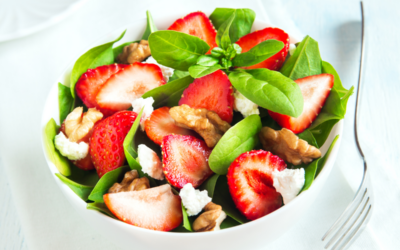This article contains affiliate links.
Summary of key points
Healthy meal planning and meal prep techniques are essential for maintaining a balanced diet and fitness goals. Here are some guidelines to help you plan and prepare healthy meals:
1. Plan your meals ahead of time: Take some time each week to plan your meals. That will help you avoid unhealthy choices on the go. Make a grocery list and stick to it when shopping.
2. Choose healthy ingredients: Include a variety of nutrient-dense foods in your meals, such as fruits, vegetables, whole grains, lean proteins, and healthy fats. Avoid processed and high-calorie foods.
3. Portion control: Pay attention to portion sizes to ensure you eat the right amount of food. Use measuring cups or a food scale to ensure accuracy.
4. Cook with healthy methods: Use cooking techniques such as grilling, baking, roasting, and steaming to prepare your meals. Avoid frying and sautéing in oil.
5. Use meal prep containers: Invest in high-quality meal prep containers to store your meals. That will help you manage portions and make it easy to grab and grab when you’re on the run.
6. Batch cook: Cook multiple servings of meals to save time during the week. Freeze leftovers for a quick and easy meal later.
7. Plan snacks: Plan healthy snacks to keep you full and energized throughout the day. Examples include nuts, fruits, vegetables, and yogurt.
8. Drink plenty of water: Staying hydrated is vital for overall health. Drink plenty of water throughout the day to avoid dehydration.
These healthy meal planning and prep techniques can make eating well more manageable and enjoyable. Remember to be consistent to make healthy choices a lifestyle and habit.
Start Meal Prepping Today
Bentgo Prep 2 Compartment Meal Prep Containers are reusable food storage containers designed to help you plan and prep your meals in advance. They are made of durable, food-grade materials and feature two compartments to keep your food items separate and fresh. These containers are ideal for individuals who want to pack healthy meals for work, school, or travel.
1. Plan your meals ahead of time
Planning your meals ahead of time is crucial to maintaining a healthy diet and achieving your health goals. Here are some tips for preparing your meals:
- Set aside time weekly to plan: Choose a specific day and time each week to sit down and plan your meals for the upcoming week. That can help you stay organized and avoid unhealthy choices.
- Take inventory of your pantry and fridge: Before planning your meals, look at what ingredients you already have. That can save money and reduce food waste.
- Choose recipes that fit your goals: Keep your health goals in mind when selecting recipes. Choose recipes that are nutrient-dense and fit within your calorie and macronutrient targets.
- Make a grocery list: Once you’ve chosen your recipes, list all the necessary ingredients. That can help you stay on track when grocery shopping.
- Prep ingredients in advance: If you have spare time, consider prepping some ingredients. For example, you can chop vegetables, cook grains, and marinate proteins beforehand.
- Consider batch cooking: Cooking in batches can save time and ensure healthy meals on hand. Consider cooking multiple servings of a recipe and freezing leftovers for later.
- Be flexible: While planning is essential, it’s also critical. If unexpected events come up, adjust your meal plan accordingly.
Following these tips can make meal planning a regular part of your routine and help you stay on track with your health and nutrition goals.
2. Choose healthy ingredients
Choosing healthy ingredients is essential for maintaining a balanced and nutritious diet. Here are some tips to help you choose wholesome ingredients for your meals:
- Focus on whole foods: Whole foods are minimally processed and contain essential nutrients. Examples of whole foods include fruits, vegetables, whole grains, lean proteins, and healthy fats.
- Read labels: When buying packaged foods, it’s essential to read labels and look for products low in added sugars, saturated and trans fats, and sodium. Choose products high in fiber, vitamins, and minerals.
- Incorporate a variety of colors: Different colors of fruits and vegetables represent different nutrients. Including a variety of colors in your diet can help ensure a wide range of vitamins and minerals.
- Choose lean proteins: Lean proteins such as chicken, turkey, fish, and tofu are low in saturated fat and high in essential nutrients like protein and iron.
- Choose healthy fats: Healthy fats such as avocado, nuts, seeds, and olive oil are essential for overall health and can reduce the risk of heart disease.
- Limit processed and high-calorie foods: Processed and high-calorie foods like sugary drinks, baked goods, and fast food are often high in added sugars, unhealthy fats, and calories. Try to limit your intake of these foods.
- Be mindful of portion sizes: Even healthy foods can lead to weight gain if consumed in large quantities. Pay attention to portion sizes and stick to the recommended serving sizes.
You can improve your overall health by choosing ingredients that are minimally processed, organic, and are good for your body. Remember to make nutrient-dense foods a regular part of your diet.
Start Meal Prepping Today
Bentgo Prep 2 Compartment Meal Prep Containers are reusable food storage containers designed to help you plan and prep your meals in advance. They are made of durable, food-grade materials and feature two compartments to keep your food items separate and fresh. These containers are ideal for individuals who want to pack healthy meals for work, school, or travel.
3. Portion control
Portion control is vital to maintaining a healthy diet. Here are some tips to control your portions:
- Use smaller plates: Smaller plates can help you control your portion sizes by tricking your brain into thinking you’re eating more food than you actually are.
- Measure your food: Use measuring cups, spoons, or a scale to measure your food and ensure you’re eating the recommended serving size.
- Be mindful of serving sizes: Familiarize yourself with recommended serving sizes for different types of food. For example, a typical serving of protein is 3-4 ounces, a serving of grains is ½ cup, and a serving of vegetables is 1 cup.
- Listen to your body: Pay attention to your hunger and fullness signals. Stop eating when you feel satisfied, not stuffed.
- Avoid distractions: Eating while distracted, such as watching TV or scrolling through your phone, can lead to mindless eating and overconsumption. Focus on your food and savor each bite.
- Plan ahead: If you know you’ll be eating out or attending a social gathering, plan and choose healthy options in appropriate portion sizes.
Practicing portion control can improve your overall health and manage your weight. Remember to make a variety of nutrient-dense foods a regular part of your diet and enjoy them in appropriate portions.
4. Cook with healthy methods
Cooking with healthy methods is essential for maintaining nutritional value and reducing unhealthy fats and calories. Here are some tips for cooking healthy:
- Grill, roast, or bake: Grilling, roasting, and baking are healthy cooking methods that preserve nutrients in your food and minimize added fats. Use marinades or dry rubs to enhance flavor without unhealthy fats.
- Steam: Steaming is another healthy cooking method that retains the nutritional value of your food. Use a steamer basket or a steam oven for cooking vegetables, fish, and other proteins.
- Saute with healthy fats: If you prefer to sauté your food, use healthy fats like olive oil, avocado oil, or coconut oil. These oils are rich in monounsaturated and polyunsaturated fats that improve heart health.
- Avoid deep-frying: Deep-frying foods can add unhealthy fats and calories to your diet. If you must fry, limit your portions and use healthy oils like canola or sunflower.
- Use non-stick cookware: Non-stick cookware can reduce the amount of oil or butter needed for cooking, making it a healthier option.
- Limit salt: High salt intake is linked to high blood pressure and other health problems. Instead of salt, use herbs, spices, or citrus juices to flavor your food.
Cooking with healthy methods can improve the nutritional value of your food and reduce unhealthy fats and calories in your diet. Experiment with different cooking techniques and flavors to make healthy meals that taste delicious.
5. Use meal prep containers
Using meal prep containers is an excellent way to control your portions and save time during the week. Here are some tips for using meal prep containers effectively:
- Choose high-quality containers: Invest in reliable meal prep containers that are leak-proof, microwave-safe, and freezer-safe. That will ensure your food stays fresh and is easy to store and reheat.
- Plan your meals in advance: Plan your meals for the week and prepare all the ingredients in advance. That will save time during the week and make sticking to your healthy eating goals easier.
- Divide your food into appropriate portions: Use measuring cups or a food scale to divide your food into appropriate portions. That will help you control your calorie intake and avoid overeating.
- Label your containers: Label your meal prep containers with the date and contents of each meal. That will help you track what you’ve prepared and ensure you eat everything before it becomes rotten.
- Store your containers properly: Store your meal prep containers in the fridge or freezer, depending on how long you plan to keep them. Make sure to stack them neatly and label them to find what you need quickly.
- Reheat your food safely: Always reheat your food to the appropriate temperature to ensure safety.
Meal prep containers can make healthy eating more manageable and more effortless. Remember to plan your meals in advance, control your portions, and store your food properly to ensure it stays fresh and safe to eat.
6. Batch cook
Batch cooking is an excellent way to save time during the week and ensure healthy meals. Here are some tips for batch cooking:
- Choose recipes that can be batched: Choose recipes that can be easily scaled up, such as soups, stews, casseroles, and roasted vegetables.
- Invest in large cooking equipment: Invest in large pots, pans, and baking sheets to make preparing large batches of food easier.
- Shop in bulk: For ingredients, you frequently use, such as grains, beans, and spices. That will save you money and ensure components are on hand when needed.
- Freeze leftovers: Freeze leftovers in individual portions so you can grab them when you need a quick and healthy meal.
- Label and date your leftovers: Label and date your leftovers so you can keep track of what you have in your freezer and avoid waste.
- Plan your meals in advance: Plan your meals for the week and include batch-cooked meals. That will help you avoid eating out or ordering takeout.
- Reheat your food safely: Follow safe food handling practices when heating your food.
Batch cooking saves time and ensures healthy meals are on hand. Remember to choose recipes that can be easily scaled up, shop in bulk, and freeze leftovers in individual portions. With a bit of planning and preparation, you can make healthy eating more convenient and manageable.
Start Meal Prepping Today
Bentgo Prep 2 Compartment Meal Prep Containers are reusable food storage containers designed to help you plan and prep your meals in advance. They are made of durable, food-grade materials and feature two compartments to keep your food items separate and fresh. These containers are ideal for individuals who want to pack healthy meals for work, school, or travel.
7. Plan for snacks
Planning healthy snacks is essential to maintaining a balanced diet and keeping your energy levels up throughout the day. Here are some tips to help you plan healthy snacks:
- Choose nutrient-dense snacks: Choose snacks rich in nutrients and low in added sugars and unhealthy fats. Examples include fresh fruit, vegetables, nuts, and seeds.
- Portion control: Pay attention to portion sizes to ensure you’re not consuming too many calories. Use small containers or bags to portion out your snacks in advance.
- Plan: Plan snacks so you have them when needed. That can help you avoid unhealthy snacking choices when on the go.
- Keep snacks within reach: Keep your snacks within reach at home or work so you can easily grab them when you need a quick pick-me-up.
- Make your snacks: Creating your snacks can help you control ingredients and avoid unhealthy additives. Try making your own trail mix, energy bars, or roasted chickpeas.
- Choose snacks that fit your goals: Select snacks that meet your calorie and macronutrient targets. For example, if you’re trying to lose weight, choose snacks low in calories and high in fiber.
- Stay hydrated: Drink plenty of water throughout the day to keep your energy levels up and avoid dehydration.
Planning healthy snacks can keep your energy levels up throughout the day and avoid unhealthy snacking choices. Remember to choose nutrient-dense snacks, have portion control, and keep them within reach.
8. Drink plenty of water
Drinking plenty of water is vital for overall health and well-being. Here are some tips to stay hydrated throughout the day:
- Carry a water bottle: Always keep a reusable water bottle with you and sip throughout the day. That can help you stay hydrated and avoid sugary drinks.
- Drink water with meals: Drinking water with your meals can help you feel fuller and prevent overeating. Drink at least one glass of water with each meal.
- Eat hydrating foods: Some foods, such as fruits and vegetables, contain a high percentage of water and can help you stay hydrated. Examples include watermelon, cucumbers, and strawberries.
- Avoid sugary drinks: Sugary drinks, such as soda and sports drinks, can dehydrate you and add unnecessary calories to your diet. Choose water, unsweetened, or naturally sweetened beverages instead like coconut water.
- Limit caffeine and alcohol: Caffeine and alcohol dehydrate and should be consumed in moderation. Aim to limit your consumption of these drinks and balance them with water.
- Set reminders: Set reminders on your phone or computer to remind you to drink water throughout the day.
- Listen to your body: Pay attention to your body’s thirst signals, and drink water when thirsty.
Drinking plenty of water can improve your overall health and well-being. Remember to carry a water bottle, drink water with your meals, and eat hydrating foods. Make hydration a regular part of your routine with a bit of effort.
Takeaway
Overall, meal planning and prepping can be a fun and rewarding way to eat healthier and save time, and money. Overtime, meal planning will become easier and become habitual for you. Finding a routine that works for you and sticking to it, can make meal planning and prepping a sustainable part of your lifestyle.
















